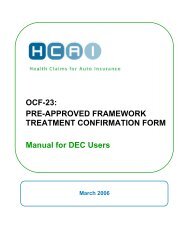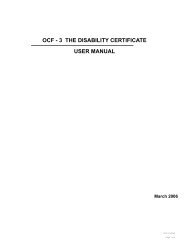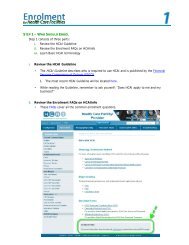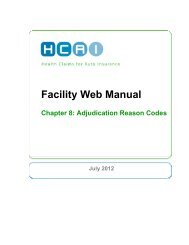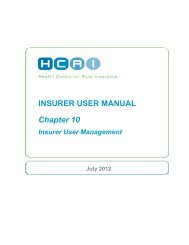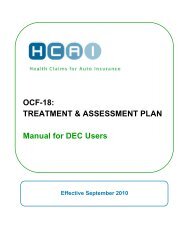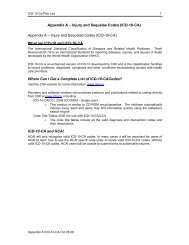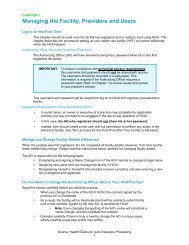OCF 23 - The Pre-Approved Framework Treatment ... - HCAI
OCF 23 - The Pre-Approved Framework Treatment ... - HCAI
OCF 23 - The Pre-Approved Framework Treatment ... - HCAI
Create successful ePaper yourself
Turn your PDF publications into a flip-book with our unique Google optimized e-Paper software.
<strong>OCF</strong>–<strong>23</strong> THE PRE-APPROVED FRAMEWORK<br />
TREATMENT CONFIRMATION FORM<br />
USER MANUAL<br />
March 2006
Document Change History<br />
Date Description of Change Reason<br />
20050214 Revised Applicant Signature, Signature of<br />
the Initiating Health Practitioner & Prior &<br />
Concurrent Conditions, Repositioned<br />
Signature of Insurer<br />
20060301 Further Information and Revised Applicant<br />
Signature<br />
Changes are underlined.<br />
For consistency with revised <strong>OCF</strong> forms<br />
01/Dec/04<br />
Redirects Users to <strong>HCAI</strong> website and<br />
revised consent for consistency.<br />
Introduction<br />
Who should use this manual?<br />
This User Manual is designed to assist both health care providers and automobile insurers in the<br />
completion of the <strong>OCF</strong>–<strong>23</strong>, <strong>The</strong> <strong>Pre</strong>-<strong>Approved</strong> <strong>Framework</strong> <strong>Treatment</strong> Confirmation Form. Other manuals<br />
are available to assist in the completion of:<br />
<strong>OCF</strong>–3 Disability Certificate<br />
<strong>OCF</strong>–18 <strong>Treatment</strong> Plan<br />
<strong>OCF</strong>–21 Auto Insurance Standard Invoice<br />
<strong>OCF</strong>–22 Application for Approval of an Assessment or Examination<br />
<strong>OCF</strong>–24 <strong>Pre</strong>-<strong>Approved</strong> <strong>Framework</strong> Discharge & Status Report<br />
Facilities and health care providers dealing with victims of motor vehicle accidents are required to use<br />
these forms.<br />
Both rehabilitation health care providers and automobile insurers have dedicated a tremendous amount of<br />
time and thought to the revision or development of the <strong>Pre</strong>-approved <strong>Framework</strong> <strong>Treatment</strong> Conformation<br />
Form and other forms. <strong>The</strong>se forms will improve the accountability of all parties, streamline the process<br />
of delivering health care services to applicants, and enhance communication between insurers and health<br />
care professionals.<br />
<strong>The</strong> forms are designed to facilitate a clear understanding of the interactions amongst an injured motorist,<br />
a health care professional and an insurer through the use of common terms and language. All forms use<br />
the national coding standards, the International Statistical Classification of Diseases and Related Health<br />
Problems, Tenth Revision, Canada (ICD-10-CA) 1 , to identify injuries and the Canadian Classification of<br />
Health Interventions (CCI) 1 to classify health care services and procedures.<br />
1 ICD-10-CA and CCI are copyright products of the Canadian Institute for Health Information (CIHI) and may not be changed<br />
without the Institute’s express permission.<br />
1
What is in this manual?<br />
<strong>The</strong> manual provides detailed instructions for completion of the fields in the order in which they appear on<br />
the forms. <strong>The</strong> appendices include tables of standardized codes and descriptions for the various codified<br />
fields used on the forms.<br />
Where can I get more information?<br />
<strong>The</strong> manual will be updated from time to time. <strong>The</strong> latest updates to the manual can be downloaded from<br />
the website www.hcaiinfo.ca under Auto Insurance Resources>Statutory Accident Benefits>User<br />
Manuals.<br />
Contact your professional association for any questions relating to coding of injuries, interventions, health<br />
care services and guidelines as they relate to your specific practice.<br />
Samples of Completed Sections of the Forms<br />
<strong>The</strong> samples and fees used throughout the manual are entirely fictitious. <strong>The</strong>y are designed to<br />
assist you in understanding how to use and complete the forms.<br />
2
<strong>OCF</strong>-<strong>23</strong><br />
<strong>Pre</strong>-approved <strong>Framework</strong> <strong>Treatment</strong> Confirmation Form<br />
Background<br />
<strong>The</strong> health practitioner who initiates pre-approved treatment for an injury defined in a <strong>Pre</strong>-approved<br />
<strong>Framework</strong> (PAF) must fully complete a <strong>Pre</strong>-approved <strong>Framework</strong> <strong>Treatment</strong> Confirmation Form, <strong>OCF</strong>-<br />
<strong>23</strong>, in order to establish the Initiating Health Practitioner’s right to reimbursement for the delivery of PAF<br />
treatment. <strong>The</strong> <strong>OCF</strong>-<strong>23</strong> is also the form used to request insurer approval of those treatments that are<br />
permitted to be delivered together with treatment in the PAF, but which also require insurer approval.<br />
Purpose:<br />
• To describe the injuries which are a direct result of the motor vehicle accident.<br />
• To identify to the insurer the relevant PAF program of care and any related pre-approved goods<br />
and services that will be provided.<br />
• To request insurer approval of any treatments permitted in the PAF that require pre-approval.<br />
• To provide speedy confirmation to the provider that there is an insurance policy in existence to<br />
enable reimbursement.<br />
• To identify any prior conditions and/or barriers to recovery that could affect the claimant’s<br />
response to the treatment.<br />
This form may not be materially altered; in other words, the document cannot be changed in any manner.<br />
If this document is materially altered, it may be considered incomplete and the insurer may not accept the<br />
form.<br />
When is an <strong>OCF</strong>-<strong>23</strong> required?<br />
<strong>The</strong> initiating practitioner must submit the <strong>OCF</strong>-<strong>23</strong> as soon as possible and no later than five days<br />
following the practitioner’s first encounter with the claimant. After receipt of the <strong>OCF</strong>-<strong>23</strong>, the insurer has<br />
five days to inform the provider that there is an insurance policy in place to respond to invoices.<br />
<strong>The</strong>re will normally be only one <strong>OCF</strong>-<strong>23</strong> per patient. However, exceptions to this can occur, including<br />
when:<br />
• an ancillary service* is proposed by the initiating practitioner, family physician or insurer, either<br />
when the PAF is initiated or after treatment is underway. <strong>The</strong> proposal and approval of the<br />
ancillary service are documented through an <strong>OCF</strong>-<strong>23</strong> that is signed by the initiating health<br />
practitioner or the patient’s physician. Thus, if the insurer wishes to initiate an ancillary service,<br />
the insurer shall do so by contacting either the initiating practitioner or the patient's family<br />
physician, who will complete the <strong>OCF</strong>-<strong>23</strong>.<br />
• the initiating practitioner determines, after treatment is underway, that the patient needs a good<br />
(e.g. equipment) to support treatment or that a supplementary condition exists which requires the<br />
Supplementary Condition service.<br />
• the patient decides to change practitioners while there are resources remaining in the PAF, in<br />
which case the patient and second practitioner must inform the insurer through submission of a<br />
new <strong>OCF</strong>-<strong>23</strong>.<br />
• the initiating provider of a WAD I PAF determines that the patient is more appropriately treated in<br />
the WAD II PAF. In this case, the total cost of PAF treatment must not exceed the cost of the<br />
WAD II PAF and must be documented in a new <strong>OCF</strong>-<strong>23</strong>.<br />
* Refer to the PAF Guidelines for more information. An Activities of Normal Life Intervention (ANLI) is<br />
used to identify and evaluate areas of functional difficulty or barriers to recovery and to implement<br />
strategies for recovery.<br />
3
Who completes this form?<br />
<strong>The</strong> health practitioner who undertakes the responsibility for treating the patient in the PAF completes and submits the<br />
<strong>OCF</strong>-<strong>23</strong>. By signing Part 5, the health practitioner is affirming that the goods and services contemplated are reasonable<br />
and necessary for the injuries described in Part 6.<br />
<strong>The</strong> applicant or a substitute decision maker completes Part 1 and 2 and signs Part 13. <strong>The</strong> Substitute Decisions Act<br />
states that a substitute decision maker is a person with power of attorney for personal care or a court appointed guardian.<br />
<strong>The</strong> insurer completes Part 12 and returns a copy of the page to the applicant and the health practitioner.<br />
Fee<br />
<strong>The</strong> fee for completion of this form is embedded in the block funding structure of the PAF. <strong>The</strong>refore, the insurer may not<br />
be billed separately for completion of this form.<br />
Return this form to:<br />
Enter the name and mailing address of the Insurance Company responsible for handling the claim.<br />
Claim Identifiers<br />
<strong>The</strong> Applicant must indicate the claim number if known, the policy number, and the date of the accident. <strong>The</strong> claim<br />
number and policy number can be obtained from the insurance adjuster. <strong>The</strong> policy number is also available on the Motor<br />
Vehicle Liability Insurance Card (pink slip) received with the policy declaration.<br />
<strong>The</strong> Claim Number and Policy Number may be the same.<br />
<strong>The</strong> accident date must be completed. Forms will not be processed without it. If a patient has overlapping injuries<br />
from more than one accident, use the date of the accident that is most relevant to the injuries being treated.
Part 1<br />
Applicant Information<br />
To be completed by the Applicant.<br />
Part 2<br />
Insurance Company Information<br />
To be completed by the Applicant.<br />
Part 3<br />
Other Insurance Information<br />
Other insurance may be available from the Ministry of Health and Long-Term Care (MOH) or through an applicant’s<br />
personal, spousal, or parental Extended Health Care plan to cover or partially cover some or all of the goods and services<br />
listed.<br />
Indicate if the treatment you will be providing is covered by the MOH.<br />
Determine other insurance coverage that the applicant might have. Space is available for two other insurers in the event<br />
that the applicant is covered by more than one policy (for example, if both the applicant and the applicant’s partner or<br />
legal guardian have extended health benefits).<br />
<strong>The</strong> auto insurer is not liable for any costs which are payable by any other insurer.<br />
5
Part 4<br />
Conflict of Interest Definition<br />
Before proceeding to the rest of the form, determine if you have a conflict of interest relating to this <strong>Pre</strong>-approved<br />
<strong>Framework</strong> <strong>Treatment</strong> Confirmation Form.<br />
Part 5<br />
Signature of Initiating Health Practitioner<br />
Only Health Practitioners can initiate a PAF. According to the Statutory Accident Benefits Schedule (SABS), health<br />
practitioners are chiropractors, dentists, nurse practitioners, occupational therapists, optometrists, physicians,<br />
physiotherapists, psychologists and speech-language pathologists. Only the Initiating Health Practitioner or the family<br />
physician may sign Part 5. <strong>The</strong> signature is required before the form can be submitted to the insurer.<br />
If you are not the first initiating health practitioner, you must check the box provided.<br />
If the insurer wishes to initiate an ancillary service, the insurer shall do so by contacting either the initiating practitioner or<br />
the patient's family physician, who will complete the <strong>OCF</strong>-<strong>23</strong>.<br />
Before signing Part 5, confirm that the requirements for informed consent have been met. <strong>The</strong> inclusion of a revised<br />
statement of understanding identifies for the Initiating Health Practitioner the range of specific uses that will be made of<br />
information related to providing services to injured auto insurance claimants.<br />
6
Part 6<br />
Injury and Sequelae Information<br />
Provide a brief description of the injury and the corresponding injury code (ICD-10-CA code). List the PAF injury first. Up<br />
to four injuries/sequelae may be entered including the description and a valid ICD-10-CA code.<br />
Refer to Appendix A for further information on ICD-10-CA.<br />
Refer any questions regarding injury coding to your provider association or access the website at www.hcaiinfo.ca under<br />
Auto Insurance Resources>Statutory Accident Benefits>Codes and Appendices.<br />
Part 7<br />
Prior and Concurrent Conditions<br />
<strong>The</strong> information provided in this section will help the insurer to better understand the applicant’s pre-accident status and<br />
informs the insurer in advance of any pre-existing condition that may affect the applicant’s response to the treatment given<br />
within the PAF. Provide relevant information in response to these questions to the best of your knowledge and based on<br />
information from the applicant. A response of “Unknown” may prompt a request for further clarification from the insurer.<br />
Inclusion of the question on employment status expands on the insurer’s understanding of the applicant’s pre-accident<br />
status.<br />
7
Part 8<br />
Barriers to Recovery<br />
Identify any barriers to recovery, including any “yellow flags” identified in the PAF outline that may affect the success of<br />
this treatment.<br />
Refer to Appendix G for further information on “yellow flags” specific to the PAF.<br />
Part 9<br />
PAF <strong>Pre</strong>-approved Services<br />
Identify the PAF guideline under which you are treating (e.g., WAD II PAF) and indicate the maximum fee allowed under<br />
this PAF as well as your estimated fee for provision of the services. <strong>The</strong>se two numbers may be different if you anticipate<br />
that not all blocks of the PAF will be required in order to treat and discharge this patient.<br />
Identify any pre-approved Supplemental Goods, Condition Services or other pre-approved services allowed under the<br />
PAF guideline that the patient will require, and insert the associated maximum and estimated costs.<br />
Part 10<br />
Other Health Providers<br />
This part should be filled in only if there are goods and services requiring prior approval (Part 11).<br />
Health Providers are assigned an upper case alphabetic letter (i.e., the Provider Reference). <strong>The</strong> Provider Reference<br />
letters are used to cross-reference information on the <strong>Pre</strong>-approved <strong>Framework</strong> <strong>Treatment</strong> Confirmation Form and the<br />
Automobile Insurance Standard Invoice.<br />
Assign a Provider Type code for each of the health professionals rendering services or prescribing goods.<br />
8
Refer to Appendix E for a complete list of Provider Type codes.<br />
If you are a regulated health professional, provide your college registration number and leave the AISI number blank. If<br />
you are an unregulated provider, you can obtain an AISI number by registering at www.hcaiinfo.ca.<br />
NB Future implementation of the <strong>HCAI</strong> system may eliminate the need for an AISI number.<br />
Because hourly rates are generally not applicable to <strong>Pre</strong>-approved <strong>Framework</strong>s, enter N/A (not applicable). <strong>The</strong> exception<br />
to this is the Activities of Normal Living Intervention (ANLI), for which the hourly rate of the provider must be entered.<br />
Part 11<br />
Other Goods or Services within the PAF Guidelines Requiring Insurer Approval<br />
This section is for services allowable under the PAF Guideline, but still requiring insurer approval.<br />
Description<br />
Enter a description of the good or service provided.<br />
Code and Attributes<br />
For those services representing a diagnostic, therapeutic, or health care support intervention, enter a valid CCI code and<br />
attribute if required.<br />
Refer to Appendix B for a list of CCI codes and corresponding Attribute Codes.<br />
For Goods, Administration and other codes (GAP) not included in the CCI code set, enter a valid GAP code.<br />
Refer to Appendix C for a list of valid GAP codes<br />
Refer any questions regarding goods and service coding to your provider association or access the website at<br />
www.hcaiinfo.ca.<br />
Provider Reference<br />
Enter the Provider Reference code of the professional who will render the service or is prescribing the good (from Part<br />
10).<br />
When a service is to be provided by more than one health care professional, enter all Provider Reference codes<br />
(separated by commas).<br />
9
Estimated<br />
In the three columns under this heading, you are to enter the elements of information that are needed to calculate the<br />
estimated total cost of each good and service that will be delivered.<br />
• First, enter the total quantity of the good or service that will be delivered; this will appear as a number (e.g., 75, 6,<br />
52…).<br />
• Second, identify the unit of measure (e.g., hours of service, number of pages, kilometres of travel) for the quantity<br />
of service you are proposing to deliver each treatment day.<br />
• Third, report the cost per service.<br />
Sub-Total<br />
Enter the total cost of goods or services proposed in Part 11.<br />
Total<br />
Enter the combined total of the estimated fees from Part 9 and Part 11.<br />
Part 12<br />
Signature of Insurer<br />
<strong>The</strong> insurer will complete this section and return page 3 to the applicant and the Initiating Health Practitioner indicated in<br />
Part 5. If there is a service requiring insurer approval on the plan, and the insurer partially approves or does not approve<br />
the treatment, it must provide an explanation as to why the additional service has been declined. In this case, the provider<br />
may submit a <strong>Treatment</strong> Plan (<strong>OCF</strong>-18) for the declined services, and approval will be subject to the SABS<br />
10
Part 13<br />
Signature of Applicant<br />
(Partial Print Screen)<br />
After you have reviewed the form with the applicant, the applicant or the applicant’s Substitute Decision Maker, as defined<br />
in the Substitute Decisions Act, must sign here. <strong>The</strong> insurer may elect to waive the requirement of the applicant signature,<br />
but this should be ascertained in advance.<br />
<strong>The</strong> consent for the use of information has been revised to reflect the current privacy legislation and other legislation with<br />
which insurers must comply. Insurers are responsible for ensuring that claimants understand these conditions when<br />
initiating a claim through the submission of an <strong>OCF</strong>-1.<br />
Should the claimant require more information about the consent and their obligations, please refer him/her to their<br />
insurance claims adjuster.<br />
11





